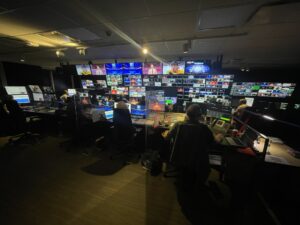NHL Heritage Classic 2023: Sportsnet Preps for Outdoor ‘Battle of Alberta’ With Spidercam, NHL-Powered Drone, Remotely Produced Studio Show
The production has come a long way since the first edition, in 2003
Story Highlights
Returning last year after a brief hiatus in 2020 and 2021, the NHL Heritage Classic will take to Commonwealth Stadium in Edmonton, AB, for an outdoor clash between longtime rivals the Edmonton Oilers and the Calgary Flames. For this tentpole event north of the border on Sunday, Oct. 29, at 7 p.m. ET, Canadian broadcaster Sportsnet will take the lead, with tech highlights including a four-point Spidercam system and a remote production of the onsite studio show from its two-year-old production facility in Toronto.
“The number-one challenge is always the concern about weather,” says Murray Corbett, director, NHL remote operations, Sportsnet. “[Commonwealth Stadium] is a venue we’re familiar with and have worked out of in the past. We also have a lot of local crew who work in Edmonton and have previous work producing football in this stadium.”

Sportsnet’s Toronto facility will remotely produce the onsite studio show for the NHL Heritage Classic.
Capturing On-Ice Action: Spidercam and Drone in the Air, Ankle Cams on the Ground
Given the sheer size of the facility — Commonwealth Stadium can seat upwards of 55,000 fans — Sportsnet can deploy technologies that a typical NHL venue can’t accommodate. For instance, the Spidercam will be able to fly over the ice without obstruction since there’s no LED centerhung to get in the way. Without a roof or covering over the playing surface, the NHL’s Entertainment division will fly a drone for live shots, sharing the feeds with Sportsnet. The approximately 24 cameras for live game coverage include seven hard cameras, five handhelds, three robos, and POVs installed in each team’s penalty box. Closer to the ice, six Q-Ball robotic cameras will serve as Ankle Cams — positioned near the bottom of the boards, behind the glass, and through small holes for spectacular views of the players.
For pregame ceremonies and activations during intermission, an operator on skates will use an RF handheld to shoot on the ice. A shallow–depth-of-field camera will be used to capture cinematic shots of the game-day atmosphere. In addition, a jib camera will be deployed and shared with the onsite studio show. As for audio, a Dolby 5.1 configuration is designed to maximize the sound of hockey played in an outdoor setting, which is different from the typical setup for a game normally played in a confined space.
“We’re following the standard protocol that the NHL provides us for indoor games with the placement of microphones around the boards, blue lines, center line and behind each goal,” says Corbett, “but we’re enhancing our coverage with some RF microphones in the nets and in and around the building. With a 50,000-seat outdoor stadium vs. a 20,000-seat indoor venue, there’s a lot more interfacing going on with in-house audio because of the entertainment component. I would describe [this production] as having a bigger quantity of microphones.”
From Edmonton to Toronto: Onsite Studio Show To Be Remotely Produced
Sportsnet will have a crew of 50 onsite. A major portion will be local workers from the western side of the country, but a good chunk of the workforce will be staffers traveling from their home base in Toronto.
“Some of our key personnel will travel like they do for most of our tentpole events,” says Corbett. “They all come with a lot of working experience; it’s nice to know that the people you’re working with have also been involved at an NHL All-Star Game, an NHL Draft, or an NHL Stanley Cup Final.”
The onsite crew includes Director John Szapala, Producer Scott Carruthers, Technical Producers Myriam Dickner and John Cuccaro, Technical Director Caitlind Lusty, A1 Gabriel Scoppa, Video Engineer Gaby Almeida, and Lead Graphics Operator Kevin Schnurr. Housing the team and driving the production in Edmonton, Dome Productions Silver is parked in the broadcast compound. In Toronto, a 25-person team will handle a remote production of Hockey Night in Canada, which will provide pre/postgame and intermission analysis from the venue.
“We’re also moving our Saturday-night show to Edmonton,” says Joel Darling, executive producer, NHL Special Events, Sportsnet. “All of our studio coverage for every game that day will come from [Commonwealth Stadium] to help us build the excitement for Sunday. There will be two productions going on: one onsite covering the game and another being produced by our production crew back in Toronto.”
Dome Productions Silver, along with a flypack in an office trailer, will be sending video feeds to Toronto for the final cut to be put together and distributed. The flypack is also being used to bring sources from games around the league to the talent at the desk on the field. Spearheaded by Technical Producer Alex Harwood and Broadcast Engineer Craig Moorman, the remote production is intended to replicate for the analysts the feel of an indoor show in Toronto.
“They’re normally in a green room at our studios, where all of the games are coming in,” says Corbett. “The extra layer of complexity is re-creating that environment for them so that they can host the show from Edmonton.”
Looking Back to 2003: Crew Adapts to New Workflows, Production Techniques
Twenty years ago, the Montreal Canadiens and Edmonton Oilers faced off in the NHL’s first-ever outdoor game during the regular season on Nov. 22, 2003, at Commonwealth Stadium. With an attendance of 57,167, the game sits just outside the Top 10 as the 12th-most-attended outdoor hockey game in the league’s 40 official efforts. At puck drop, the temperature reached -2 degrees, which wasn’t far off from the coldest game-time temperature ever, during the 2022 NHL Winter Classic. Darling and play-by-play commentator Chris Cuthbert are two of the few members left from the CBC team that produced that first game, and Darling remembers the challenges of a show that didn’t have much of a blueprint to work with.
“It was actually the first HD broadcast on CBC,” he notes. “We ended up using a Japanese–game-show truck out of New York City because we didn’t have an HD truck in Canada at the time. I can remember the number of meetings that we had trying to understand how the setup would be different. One of the biggest issues that we had with a truck that wasn’t normally used for sports was the snapping of cables; we lost a lot of cameras throughout the day.”

Twenty years after the first NHL Heritage Classic, Commonwealth Stadium will once again host outdoor hockey.
Two decades later, the lessons learned in this stadium and from the Heritage Classic’s maiden effort have proved pivotal to the production’s maturation and improvement. The biggest change for Cuthbert? He’ll be calling the action, alongside analyst Craig Simpson, down by the ice instead of up in the broadcast booth. To Darling, the biggest change is refining the production to maximize the gear at the crew’s disposal and optimize the look and feel for viewers watching at home.
“We’re continuing the same conversations that we had 20 years ago, including how to make this event intimate, where to place cameras, and what the best angles are,” he says. “We can get more intimate by having Spidercam, which we didn’t have in 2003, as well as some of the RF equipment and Ankle Cams that we have down near the ice. The great thing about this game is that there’s still a curiosity factor because people like to watch a game that’s outdoors.”
With the technical support from NHL VP, Arena and Event Operations, Dan O’Neill and the creative guidance of NHL CCO/EVP Steve Mayer, the collaboration with the league is turning the CFL-centric venue into the center of the NHL world for one night. After years of reps and focusing on a successful production formula, the league and Sportsnet will tap into what works best on Sunday night.
“Even though every stadium is different,” says Darling, “the NHL now has a blueprint, and [the broadcasters] know what to expect.”
Continuing the Tradition: Sportsnet, NHL Prepare for Another Outdoor Spectacle
For the players, the NHL Heritage Classic is a return to their roots, and, with the added fire of “Battle of Alberta,” the 2023 NHL Heritage Classic has the makings of another fun day on the pond.
“Everybody knows that Oilers–Flames is a great rivalry,” says Darling. “The outdoor games are always special, and, while we’re hoping for good weather, sometimes bad weather makes it even more interesting.”
U.S. viewers can watch the 2023 NHL Heritage Classic on TBS and stream live with B/R Sports on Max.
